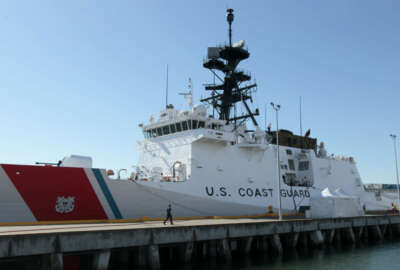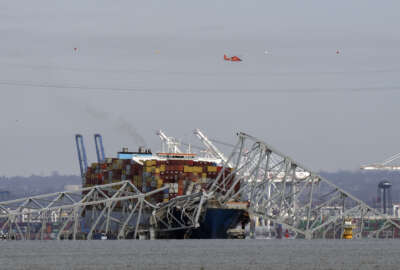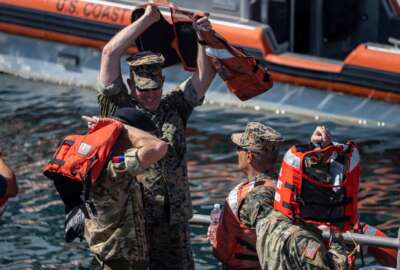The Coast Guard is working overtime on the Baltimore bridge that was knocked into the harbor
The Coast Guard may be the most active federal agency in the aftermath of the Baltimore bridge that was knocked over by a container ship.
The Coast Guard may be the most active federal agency in the aftermath of the Baltimore bridge that was knocked over by a container ship. For a summary of what it’s had to do so far and the resources it’s deployed, the Federal Drive Host Tom Temin spoke to Baltimore District Commander Col. Estee Pinchasin.
Interview Transcript:
Estee Pinchasin We’re about a week and a day in to the operation. The first day you remember was search and rescue and then recovery. We shifted to recovery operations, and it’s very hard decision to then go into salvage, because at that point we realized it was just too dangerous. The wreckage was so unstable that we didn’t want to put the divers in a in a dangerous situation. So we shifted to salvage operations. And in the meantime, we’ve marshaled the most incredible team resources, equipment to be able to tackle this. And you’ve got three efforts. You’ve got the channel, the 50 foot shipping channel that needs to be cleared and opened. You’ve got the vessel that needs to be refloated. And in the area outside the channel, there’s the bridge wreckage that needs to be removed. So that will rebuild the Francis Scott Key Bridge, as the governor describes. You need to know that while you’ve got these three efforts, they are being coordinated in an overarching manner through the Unified Command the U.S. Army Corps of Engineers has brought on the supervisor of salvage from the United States Navy. Those are our nation’s top salvage experts reaching into the salvage community. So we’ve got the right team here. And it’s not just about the wreckage. It’s not just about the engineering to get the wreckage out. We know that recovery of those four unaccounted personnel is a part of this. So when we see the salvage operations that are going to be taking place in earnest, need to know that this is going to be an iterative process with every layer of wreckage that we pull up, we have to go back in and scan and survey and inspect to make sure that the load reacted the way we believed it would, that it’s as stable as it needs to be, so that the next iteration can be done safely. But they’re also going to be looking for any signs of the missing personnel or any areas that need further inspection that they could possibly be found. We all recognize that’s a very integral part of this operation. We’re not forgetting that it’s a part of every step.
Eric White I don’t know if you have exact numbers or anything like that, ballpark is perfectly fine. As far as those resources from the Army Corps of Engineers itself. Can you just kind of tell me the sort of equipment and personnel that your agency is deploying to the situation?
Estee Pinchasin So right off the bat, the Corps started deploying its emergency response personnel. We brought in structural engineers from within the Baltimore district, but also from our structural center of expertise. Over in Philadelphia district, we launched survey operators and vessels from Philly as well to join up with the Baltimore district teammates. We brought in emergency managers and experts from areas around the corps. I don’t know how much people know about the Corps of Engineers, but we’re 38,000 people strong that literally build our country. We are engineering that our vision is engineering solutions to our nation’s challenges. And this is exactly what that is. But we bring in other partners as well. And that’s where the Navy and tying in with the Coast Guard in this unified command, all our state and federal partners, it’s a very powerful partnership. Another thing to remember is that this community and this the Baltimore community, we work together in this port on these channels all the time. The Baltimore District of the Corps of Engineers clears, navigational hazards and maintains the depth of these channels all the time, whether people realize it or not. When they’re ordering things on Amazon, that’s why that’s happening for our port. So the team that was able to spring together had the preexisting human infrastructure of relationships to come together quickly. There wasn’t a learning curve in figuring out who’s who. So that that made this response very quick and efficient.
Eric White Yeah, I wanted to touch on that. This is a good segue into, this is such a heavy undertaking. How are you maintaining the standard operations that your district already does, the important work that your district is already responsible for, while also contributing to this recovery and rebuilding effort?
Estee Pinchasin We are not doing this alone. When I mentioned that unified command, the Coast Guard, who is responsible for the overall waterway and their sector commander, Captain Dave O’Connell, he is the captain of the port. So he’s here with a massive amount of personal experience and expertise to put together this unified command, along with the state, along with the military, with the Maryland State Police, all the state agencies, federal partners supporting and helping. We also have the responsible individual that represents the shipping company who is responsible for removing and refloating the vessel. So this is not done alone with the Corps. The Corps doesn’t do anything alone. We are very reliant on our partners and especially our partners in industry.
Eric White And apart from the government agencies that you’re working with, what sorts of contractors have you all been working with in order to get this thing underway? I imagine somebody’s got to have those cranes. Somebody is the shipping company.
Estee Pinchasin Like I mentioned, we’ve got these three lines of effort we have, and I’m talking from a salvage operations. The governor put out our priorities. We know the top priority is recovering those families, that recovering the missing from our families that are still here in Baltimore. When I step down and do just the salvage operation, we’ve got three efforts here. We’ve got restoring the 50 foot federal channel, the shipping channel. We’ve got refloating the vessel. And then we also have to restore the overall waterway so we can rebuild the bridge. We have three salvage then that are working, that are salvage experts, that are working to restore all the conditions in the channel. And they’re working together. They’re sharing information. They’re sharing coordinated under the unified command through the Corps. But with the help of our partners in United States Navy, the sup sal, or supervisor of salvage operations for the Navy, and they come in with salvage expertise that can’t be matched. And it’s humbling to see, it’s inspiring to me as an engineer to see them duking it out and figuring out the best way to get after these things. There’s such passion here. And I think that for a lot of folks, any construction project, any dredging project, any major operation that’s taking place usually have these big, major pieces of equipment moving. And that’s when you think things are happening. But behind every one of those lists is a tremendous amount of engineering analysis that has to take place for them to figure out where to cut, how to cut, how to rig it, how to lift it. I’m learning so much about salvage operations through here that to understand that sometimes rigging a particular load, if we’re going to lift something that’s near 1,000 pounds, because that’s what we’ve got here, we’ve got a 1,000 ton crane that can lift a load that much of the Chesapeake 1,000. You might hear it being referred to on the radio as a chassis. If that’s going to lift 1,000 pounds, you’re going to have a lot of stabilization that’s taking place. You might have additional cranes that are stabilizing other parts of the spans that are being cut and then lifted. Behind every one of those lifts, someone is designing how to cut it, how they’re going to rig it, how they’re going to lift it. And they’re planning to do that not just to get it up. They’re planning on how they’re going to lift it so that the load underneath will react a certain way, so as to not endanger the crane operator and not to make the conditions more dangerous or complicated later. They’re looking long term out.
Eric White Are there any sorts of timelines that have been established yet, or is it just still so early?
Estee Pinchasin No, it’s so early. And I mean, honestly, we’re focused right now on clearing the channel and hopefully recovering our missing personnel. From my vantage point that’s our top priority, giving closure to those families that just celebrated Easter in an unthinkable way and trying to find a way to work as close as we can safely and as quickly as possible to get as much traffic as we can back going through to the Port of Baltimore. We’ve got 8,000 workers from that port. It had to make a mortgage payment two days ago. I think about that. That’s what’s motivating me, because I know the Corps serves our country, but we’re serving our people. And I know people can say, that sounds cheesy, but that’s exactly what that is. That’s always serving.
Eric White And can you tell me just about how you heard about when it happened? It happened overnight. Living here in Maryland myself, all my social media feeds were ablaze when this occurred. Can you just kind of take me through how you were alerted that such an event had occurred?
Estee Pinchasin So it’s interesting how it happened. My mother in law was the first person to call my husband’s phone. And as he hands me the phone and he tells me this, I pick up the phone and my phone starts going crazy. I mean, thank God for her. She’s up early. She’s incredible. She was the one that made the first call. Maybe we have to hire her into our emergency operations section, but, yeah, that was my first call. If anybody really wants to know on the record. And then I started getting calls while I’m on the phone with her internal to my organization. So from that, I call immediately to, captain O’Connell with the Coast Guard. And, we’ve been here together ever since. But you need to know that we know that this is a long road. We are getting our team together every day. We’re already looking at further out who’s going to come and replace our folks and everything that we’re working on for these intermediate milestones before we get the port completely open. And I think that’s the right answer. You don’t want to sprint and then die. You want to make sure that you can go in it for the long term, so that you’re fresh and sharp and thinking as clearly as you can bring in the assets that you need. So, that’s our plan. We have a good battle rhythm going, lots of good decision making and analysis. So I’m very proud of team. Can’t say enough about them.
Eric White One last question here. I know you’re busy, so I’ll let you go, but you’ve been here a while now. I’ve lived in Maryland all my life. Can you just talk a little bit about the uniqueness of these bridges? We’ve got the Bay bridge, and then we have also the Key Bridge. Just these long bridges over a big stretch of body of water that is so important in shipping, important shipping lanes. Where does that factor in of as far as just the amount of material that is required to build these bridges and now are in the body of water themselves? And what that means.
Estee Pinchasin It’s really complex. I think when you look on the horizon right now and your heart sinks when you see it from far away, that gorgeous bridge that you would see in the distance that’s now broken up in the water. I have to tell you, it can be a little misleading, because when you’re looking at it from a distance, you see these spans that are sticking out of the water. And you look at it looks like there’s some structural integrity there. They might they look like they’re kind of intact. As you start to get below the water and into the mud line, especially further down, we’re seeing through 3D side scan sonar. We’re getting a much better picture of the extent of the damage, and it is far more than we thought. When you look at it, your imagination will take you down and you almost think like that span is just going straight down. But as you start to get deeper and deeper, that is 50ft down, and that 50 foot channel is mangled and cantilevered, and there are portions of it that are completely crushed. They’re completely collapsed. So when we talk about cutting out these spans into bite sized pieces, and those bite sized pieces are hundreds of tons and being lifted up. You can envision it. It’s not easy when you see the imagery of the person on the truss and you know that he’s got three stories of building above him and three stories of building below him, and he’s cutting. You start to see the magnitude of this, but you can still envision I’m going to cut through. We’re going to have these pieces being taken off. As you start to get into the water, and you start to see the mangled mess that is displaying with the 3-D imagery. You start to realize that it’s much more complex, and being able to pull that out is going to require a lot of ingenuity, and they’re going to use different types of equipment for that. They’re going to they have cranes, heavy cranes that you might see. You might have heard about the Chessie 1000 being here, but you’re going to see they’re going to have to have grabbers and salvage buckets that are going to pull out wreckage. So it’s going to be an amazing feat. And I have no doubt we have the right team. 100% we have the right team. And Baltimore is going to come back from this. I hear the mayor, I hear the governor, our team. And a part of that is also just making sure that we give closure to the families that are part of this, too.
Copyright © 2025 Federal News Network. All rights reserved. This website is not intended for users located within the European Economic Area.
Tom Temin is host of the Federal Drive and has been providing insight on federal technology and management issues for more than 30 years.
Follow @tteminWFED






